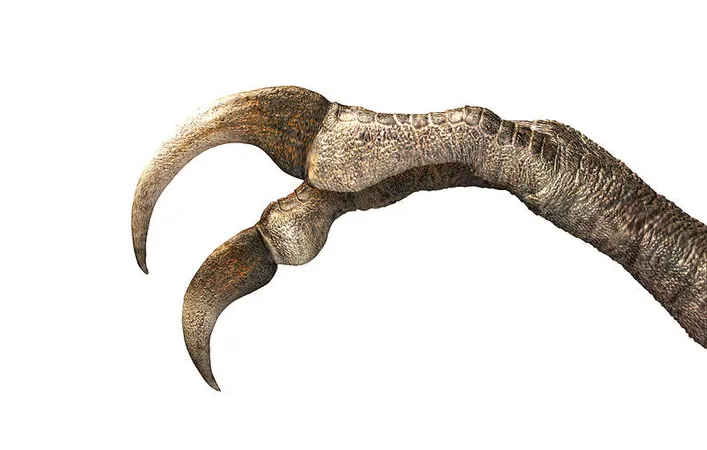
Unearthed Uniqueness: The Bizarre Clawed Dinosaur of Mongolia
2025-03-27
Author: Jacob
Recent fossil discoveries in the Gobi Desert of Mongolia have unveiled a most peculiar dinosaur species, giving new insight into the diverse adaptations that dinosaurs underwent millions of years ago. Named Duonychus tsogtbaatari, this extraordinary creature measured about 3 meters in length and weighed around 260 kg, living approximately 90 to 95 million years ago during the Cretaceous Period. Its defining feature? A pair of impressive curved claws measuring nearly 30 cm long.
Duonychus is classified as a therizinosaur, a group of dinosaurs characterized by their unusual physique, including rotund bodies, long necks, small heads, and notably, massive claws. Unlike their theropod relatives such as the notorious Tyrannosaurus rex, which were predominantly carnivorous, therizinosaurs like Duonychus were herbivores with a penchant for plant-based diets.
Traditionally, therizinosaurs were known for having three functional claws on each hand, making Duonychus's two-clawed appendages a notable anomaly, as its name aptly translates to “two claw.” As Yoshitsugu Kobayashi, lead author of the recent study published in the journal iScience, highlighted, "Duonychus takes that weirdness even further,” hinting at the exploration of evolutionary experimentation within the dinosaur kingdom.
This particular specimen, while not fully grown, inhabited a semi-arid environment rife with diverse dinosaur species, including armored dinosaurs, horned dinosaurs, and early relatives of the T. rex, such as Alectrosaurus. Although the fossil remains were incomplete—lacking both the skull and legs—researchers were fortunate to recover well-preserved arms and hands. One significant finding was the discovery of a keratin sheath on one of the claws; remarkable preservation that provides a unique glimpse into the lifestyle and functionality of these ancient creatures.
"The claws were big, sharp, and nasty," commented Darla Zelenitsky, a paleontologist at the University of Calgary and co-author of the study. The presence of the keratin sheath, which contributes to claw length and is rarely found in dinosaur fossils, allows researchers to understand better how Duonychus utilized its hands in its daily life.
The primary function of these claws likely revolved around foraging for leaves and branches, but they could have also served various other purposes, including defense mechanisms, digging, or even perhaps brandishing them as a form of recognition among individuals of the same species.
Interestingly, the evolutionary trend of digit reduction—losing fingers or toes—has been well-documented in many lineages of dinosaurs. The earliest dinosaurs possessed five fingers, similar to humans, but many groups experienced this reduction over time for varied adaptive reasons. The discovery of Duonychus adds to our understanding of theropods, with at least five lineages now confirmed to have evolved a two-fingered characteristic independently.
But what’s the evolutionary advantage of having fewer fingers? Zelenitsky theorizes that while one might think more fingers would improve grasping capabilities for feeding, Duonychus's specialized morphology allowed it to thrive on a diet of plants effectively. Similarly, the T. rex reduced its limb size proportionally to optimize feeding strategies that focused on seizing and killing prey.
As paleontologists continue to unlock the secrets of the dinosaur past through findings like Duonychus, we gain not only a better understanding of the variety among dinosaur species but also new insights into how evolutionary paths diverged based on feeding habits and environmental challenges. Keep an eye out for further groundbreaking discoveries from the Gobi Desert—this is just the beginning!









 Brasil (PT)
Brasil (PT)
 Canada (EN)
Canada (EN)
 Chile (ES)
Chile (ES)
 Česko (CS)
Česko (CS)
 대한민국 (KO)
대한민국 (KO)
 España (ES)
España (ES)
 France (FR)
France (FR)
 Hong Kong (EN)
Hong Kong (EN)
 Italia (IT)
Italia (IT)
 日本 (JA)
日本 (JA)
 Magyarország (HU)
Magyarország (HU)
 Norge (NO)
Norge (NO)
 Polska (PL)
Polska (PL)
 Schweiz (DE)
Schweiz (DE)
 Singapore (EN)
Singapore (EN)
 Sverige (SV)
Sverige (SV)
 Suomi (FI)
Suomi (FI)
 Türkiye (TR)
Türkiye (TR)
 الإمارات العربية المتحدة (AR)
الإمارات العربية المتحدة (AR)